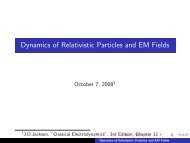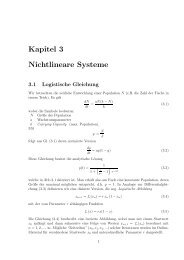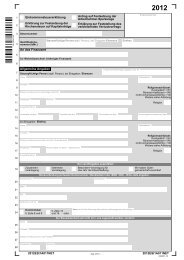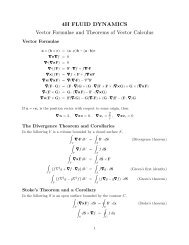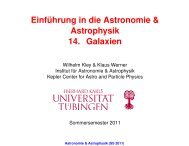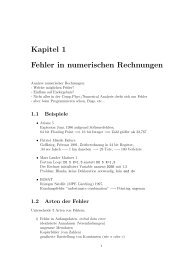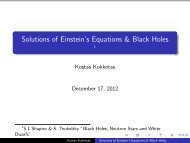Electromagnetic Waves
Electromagnetic Waves
Electromagnetic Waves
Create successful ePaper yourself
Turn your PDF publications into a flip-book with our unique Google optimized e-Paper software.
<strong>Electromagnetic</strong> <strong>Waves</strong><br />
May 4, 2010 1<br />
1 J.D.Jackson, ”Classical Electrodynamics”, 2nd Edition, Section 7<br />
<strong>Electromagnetic</strong> <strong>Waves</strong>
Maxwell Equations<br />
⋆ A basic feature of Maxwell equations for the EM field is the existence<br />
of travelling wave solutions which represent the transport of energy from<br />
one point to another.<br />
⋆ The simplest and most fundamental EM waves are transverse, plane<br />
waves.<br />
In a region of space where there are no free sources (ρ = 0, J = 0),<br />
Maxwell’s equations reduce to a simple form given<br />
∇ · E = 0 , ∇ × E <br />
1 ∂<br />
+<br />
c<br />
B<br />
∂t<br />
∇ · B = 0 , ∇ × B − µɛ<br />
c<br />
where D and H are given by relations<br />
∂ E<br />
∂t<br />
= 0<br />
= 0 (1)<br />
D = ɛ E and H = 1<br />
µ B (2)<br />
where ɛ is the electric permittivity and µ the magnetic permeability<br />
which assumed to be independent of the frequency.<br />
<strong>Electromagnetic</strong> <strong>Waves</strong>
Plane <strong>Electromagnetic</strong> <strong>Waves</strong><br />
Maxwell’s equations can be written as<br />
∇ 2<br />
µɛ<br />
B −<br />
c2 ∂2 B<br />
∂t 2 = 0 and ∇2 µɛ<br />
E −<br />
c2 ∂2 E<br />
= 0 (3)<br />
∂t 2<br />
In other words each component of B and E obeys a wave equation of<br />
the form:<br />
∇ 2 u − 1<br />
v 2<br />
∂2u = 0<br />
∂t 2 where<br />
c<br />
v = √<br />
µɛ<br />
(4)<br />
is a constant with dimensions of velocity characteristic of the medium.<br />
The wave equation admits admits plane-wave solutions:<br />
u = e i k·x−iωt<br />
E(x, t) = Ee ikn·x−iωt<br />
and B(x, t) = Be ikn·x−iωt<br />
where the relation between the frequency ω and the wave vector k is<br />
k = ω<br />
v = √ µɛ ω<br />
c<br />
or k · k =<br />
ω<br />
v<br />
also the vectors n, E and B are constant in time and space.<br />
2<br />
<strong>Electromagnetic</strong> <strong>Waves</strong><br />
(5)<br />
(6)<br />
(7)
If we consider waves propagating in one direction, say x-direction then<br />
the fundamental solution is:<br />
u(x, t) = Ae ik(x−vt) + Be −ik(x+vt)<br />
which represents waves traveling to the right and to the left with<br />
propagation velocities v which is called phase velocity of the wave.<br />
⋆ From the divergence relations of (1) by applying (6) we get<br />
(8)<br />
n · E = 0 and n · B = 0 (9)<br />
This means that E (or E) and B (or B) are both perpendicular to the<br />
direction of propagation n. Such a wave is called transverse wave.<br />
⋆ The curl equations provide a further restriction<br />
B = √ µɛn × E and E = − 1<br />
√µɛ n × B (10)<br />
The combination of equations (9) and (10) suggests that the vectors n, E<br />
and B form an orthonormal set.<br />
Also, if n is real, then (10) implies that that E and B have the same<br />
phase.<br />
<strong>Electromagnetic</strong> <strong>Waves</strong>
It is then useful to introduce a set of real mutually orthogonal unit<br />
vectors (ɛ1,ɛ2,n).<br />
In terms of these unit vectors the field<br />
strengths E and B are<br />
or<br />
E = ɛ1E0 , B <br />
√<br />
= ɛ2 µɛE0<br />
E = ɛ2E ′ 0 , B <br />
√ ′<br />
= −ɛ1 µɛE 0<br />
(11)<br />
(12)<br />
E0 and E ′ 0 are constants, possibly complex.<br />
In other words the most general way to write the electric/magnetic field<br />
vector is:<br />
E = (E0 ɛ1 + E ′ 0 ɛ2)e ikn·x−iωt<br />
B = √ µɛ(E0 ɛ2 − E ′ 0 ɛ1)e ikn·x−iωt<br />
<strong>Electromagnetic</strong> <strong>Waves</strong><br />
(13)<br />
(14)
Thus the wave described by (6) and<br />
(11) or (12) is a transverse wave<br />
propagating in the direction n.<br />
Or that E and B are oscillating in a<br />
plane perpendicular to the wave<br />
vector k, determining the direction<br />
of propagation of the wave.<br />
The energy flux of EM waves is described by the real part of the<br />
complex Poynting vector<br />
<br />
1 c<br />
S =<br />
2 4π E × H ∗ = 1 c<br />
2 4π<br />
<br />
ER × HR + EI × <br />
HI + i EI × HR − ER × <br />
HI<br />
where E and H are the measured fields at the point where S is<br />
evaluated. 2<br />
2 Note : we use the magnetic induction H because although B is the applied<br />
induction, the actual field that carries the energy and momentum in media is H.<br />
<strong>Electromagnetic</strong> <strong>Waves</strong>
The time averaged flux of energy is:<br />
<br />
<br />
c ɛ<br />
S =<br />
8π µ |E0| 2n (15)<br />
The total time averaged density (and not just the energy density<br />
associated with the electric field component) is:<br />
u = 1<br />
<br />
ɛ<br />
16π<br />
E · E ∗ + 1<br />
µ B · B ∗<br />
<br />
= ɛ 2<br />
|E0|<br />
8π<br />
(16)<br />
The ratio of the magnitude of (15) to (16) is the speed of energy flow i.e.<br />
v = c/ √ µɛ. 3 (Prove the above relations)<br />
Project:<br />
What will happen if n is not real?<br />
What type of waves you will get?<br />
What will be the form of E?<br />
3 Note: To prove the above relations use 〈cos 2 x〉 = 1/2 and since<br />
ER = ( E + E ∗ )/2 we get 〈 E 2 R〉 = E · E ∗ /2.<br />
<strong>Electromagnetic</strong> <strong>Waves</strong>
Linear and Circular Polarization of EM <strong>Waves</strong><br />
The plane wave (6) and (11) is a wave with its electric field vector always<br />
in the direction ɛ1. Such a wave is said to be linearly polarized with<br />
polarization vector ɛ1. The wave described by (12) is linearly polarized<br />
with polarization vector ɛ2 and is linearly independent of the first.<br />
The two waves :<br />
E1 = ɛ1E1e i k·x−iωt , E2 = ɛ2E2e i k·x−iωt<br />
with (17)<br />
Bi = √ µɛ k × Ei<br />
, i = 1, 2<br />
k<br />
Can be combined to give the most general homogeneous plane waves<br />
propagating in the direction k = kn,<br />
E(x, t) = (ɛ1E1 + ɛ2E2) e i k·x−iωt<br />
E(x, t) =<br />
(18)<br />
<br />
ɛ1|E1| + ɛ2|E2|e i(φ2−φ1)<br />
e ik·x−iωt+iφ1 (19)<br />
The amplitudes E1 = |E1|e iφ1 and E2 = |E2|e iφ2 are complex numbers in<br />
order to allow the possibility of a phase difference between waves of<br />
different polarization.<br />
<strong>Electromagnetic</strong> <strong>Waves</strong>
LINEARLY POLARIZED<br />
If the amplitudes E1 = |E1|e iφ1 and E2 = |E2|e iφ2 have the same phase<br />
(18) represents a linearly polarized wave with the polarization vector<br />
making an angle θ = tan −1 (ℜ(E2)/ℑ(E1)) (which remains constant as<br />
the field evolves in space and time) with ɛ1 and magnitude<br />
E = E 2 1 + E 2 2 .<br />
ELLIPTICALLY POLARIZED<br />
If E1 and E2 have the different phase the wave (18) is elliptically<br />
polarized and the electric vector rotates around k.<br />
<strong>Electromagnetic</strong> <strong>Waves</strong>
Circular Polarization<br />
• E1 = E2 = E0<br />
• φ1 − φ2 = ±π/2 and the wave becomes<br />
E(x, t) = E0 (ɛ1 ± iɛ2) e i k·x−iωt<br />
(20)<br />
At a fixed point in space, the fields are such<br />
that the electric vector is constant in<br />
magnitude, but sweeps around in a circle at<br />
a frequency ω.<br />
The components of the electric field, obtained by taking the real part of<br />
(20)<br />
Ex(x, t) = E0 cos(kz − ωt) , Ey (x, t) = ∓E0 cos(kz − ωt) (21)<br />
For the upper sign (ɛ1 + iɛ2) the rotation is counter-clockwise when the<br />
observer is facing into the oncoming wave. The wave is called left<br />
circularly polarized in optics while in modern physics such a wave is said<br />
to have positive helicity.<br />
For the lower sign (ɛ1 − iɛ2) the wave is right circularly polarized or it<br />
has negative helicity.<br />
<strong>Electromagnetic</strong> <strong>Waves</strong>
Elliptically Polarized EM <strong>Waves</strong><br />
An alternative general expression for E can be given in terms of the<br />
complex orthogonal vectors<br />
with properties<br />
ɛ± = 1<br />
√ 2 (ɛ1 ± iɛ2) (22)<br />
ɛ ∗ ± · ɛ∓ = 0 , ɛ ∗ ± · ɛ3 = 0 , ɛ ∗ ± · ɛ± = 1 . (23)<br />
Then the general representation of the electric vector<br />
E(x, t) = (E+ɛ+ + E−ɛ−) e i k·x−iωt<br />
where E− and E+ are complex amplitudes<br />
If E− and E+ have different amplitudes but the same phase eqn (24)<br />
represents an elliptically polarized wave with principle axes of the<br />
ellipse in the directions of ɛ1 and ɛ2.<br />
The ratio of the semimajor to semiminor axis is |(1 + r)/(1 − r)|, where<br />
E−/E+ = r.<br />
<strong>Electromagnetic</strong> <strong>Waves</strong><br />
(24)
The ratio of the semimajor to semiminor axis is |(1 + r)/(1 − r)|, where<br />
E−/E+ = r.<br />
If the amplitudes have a phase difference between them E−/E+ = re iα ,<br />
then the ellipse traced out by the E vector has its axes rotated by an<br />
angle α/2.<br />
Figure: The figure shows the general case of elliptical polarization and<br />
the ellipses traced out by both E and B at a given point in space.<br />
Note : For r = ±1 we get back to a linearly polarized wave.<br />
<strong>Electromagnetic</strong> <strong>Waves</strong>
Polarization<br />
Figure: The figure shows the linear, circular and elliptical polarization<br />
<strong>Electromagnetic</strong> <strong>Waves</strong>
Stokes Parameters<br />
The polarization content of an EM wave is known if it can be written in<br />
the form of either (18) or (24) with known coefficients (E1, E2) or<br />
(E−, E+) .<br />
In practice, the converse problem arises i.e. given a wave of the form (6),<br />
how can we determine from observations on the beam the state of<br />
polarization?<br />
A useful tool for this are the four Stokes parameters. These are<br />
quadratic in the field strength and can be determined through intensity<br />
measurements only. Their measurements determines completely the state<br />
of polarization of the wave.<br />
For a wave propagating in the z-direction the scalar products<br />
ɛ1 · E , ɛ2 · E , ɛ ∗ + · E , ɛ ∗ − · E (25)<br />
are the amplitudes of radiation respectively, with linear polarization in<br />
the x-direction, linear polarization in the y-direction, positive helicity<br />
and negative helicity.<br />
The squares of these amplitudes give a measure of the intensity of each<br />
type of polarization.<br />
The phase information can be taken by using cross products<br />
<strong>Electromagnetic</strong> <strong>Waves</strong>
In terms of the linear polarization bases (ɛ1, ɛ2), the Stokes parameters<br />
are:<br />
s0 = |ɛ1 · E| 2 + |ɛ2 · E| 2 = a 2 1 + a 2 2<br />
s1 = |ɛ1 · E| 2 − |ɛ2 · E| 2 = a 2 1 − a 2 2<br />
<br />
s2 = 2ℜ (ɛ1 · E) ∗ (ɛ1 · <br />
E) = 2a1a2 cos(δ1 − δ2) (26)<br />
<br />
s3 = 2ℑ (ɛ1 · E) ∗ (ɛ1 · <br />
E) = 2a1a2 sin(δ1 − δ2)<br />
where we defined the coefficients of (18) or (24) as magnitude times a<br />
phase factor:<br />
E1 = a1e iδ1 , E2 = a2e iδ2 , E+ = a+e iδ+ , E− = a−e iδ− (27)<br />
Here s0 and s1 contain information regarding the amplitudes of linear<br />
polarization, whereas s2 and s3 say something about the phases.<br />
Knowing these parameters (e.g by passing a wave through perpendicular<br />
polarization filters) is sufficient for us to determine the amplitudes and<br />
relative phases of the field components.<br />
<strong>Electromagnetic</strong> <strong>Waves</strong>
Stokes Parameters<br />
In terms of the linear polarization bases (ɛ+, ɛ−), the Stokes parameters<br />
are:<br />
s0 = |ɛ ∗ + · E| 2 + |ɛ ∗ − · E| 2 = a 2 + + a 2 −<br />
<br />
s1 = 2ℜ (ɛ ∗ + · E) ∗ (ɛ ∗ − · <br />
E) = 2a+a− cos(δ− − δ+) (28)<br />
<br />
s2 = 2ℑ (ɛ ∗ + · E) ∗ (ɛ ∗ − · <br />
E) = 2a+a− sin(δ− − δ+)<br />
s3 = |ɛ ∗ + · E| 2 − |ɛ ∗ − · E| 2 = a 2 + − a 2 −<br />
Notice an interesting rearrangement of roles of the Stokes parameters<br />
with respect to the two bases.<br />
The four Stokes parameters are not independent since they depend on<br />
only 3 quantities a1, a2 and δ1 − δ2. They satisfy the relation<br />
s 2 0 = s 2 1 + s 2 2 + s 2 3 . (29)<br />
<strong>Electromagnetic</strong> <strong>Waves</strong>
Reflection & Refraction of EM <strong>Waves</strong><br />
The reflection and refraction of light at a plane surface between two<br />
media of different dielectric properties are familiar phenomena.<br />
The various aspects of the phenomena divide themselves into two classes<br />
◮ Kinematic properties:<br />
◮ Angle of reflection = angle of incidence<br />
◮ sin i n′<br />
Snell’s law: sin r = n where i, r are the angles of incidence<br />
and refraction, while n, n ′ are the corresponding indices of<br />
refraction.<br />
◮ Dynamic properties:<br />
◮ Intensities of reflected and refracted radiation<br />
◮ Phase changes and polarization<br />
⋆ The kinematic properties follow from the wave nature of the<br />
phenomena and the need to satisfy certain boundary conditions (BC).<br />
But not on the detailed nature of the waves or the boundary conditions.<br />
⋆ The dynamic properties depend entirely on the specific nature of<br />
the EM fields and their boundary conditions.<br />
<strong>Electromagnetic</strong> <strong>Waves</strong>
Figure: Incident wave k strikes plane interface between different media,<br />
giving rise to a reflected wave k ′′ and a refracted wave k ′ . The media<br />
below and above the plane z = 0 have permeabilities and dielectric<br />
constants µ, ɛ and µ’, ɛ’ respectively. The indices of refraction are<br />
n = √ µɛ and n ′ = √ µ ′ ɛ ′ .<br />
<strong>Electromagnetic</strong> <strong>Waves</strong>
According to eqn (18) the 3 waves are:<br />
INCIDENT<br />
REFRACTED<br />
REFLECTED<br />
E = E0e i k·x−iωt , B = √ µɛ k × E<br />
k<br />
E ′ = E ′ 0e i k ′ ·x−iωt , B ′ = µ ′ ɛ ′ k ′ × E ′<br />
E ′′ = E ′′<br />
0 e i k ′′ ·x−iωt , B ′ = µ ′ ɛ ′ k ′′ × E ′′<br />
k ′′<br />
The wave numbers have magnitudes:<br />
| k| = | k ′′ | = k = ω<br />
c<br />
k ′<br />
(30)<br />
(31)<br />
(32)<br />
√<br />
µɛ , | ′ ′ ω <br />
k | = k = µ ′ ɛ ′ (33)<br />
c<br />
<strong>Electromagnetic</strong> <strong>Waves</strong>
AT the boundary z = 0 the BC must be satisfied at all points on the<br />
plane at all times, i.e. the spatial & time variation of all fields must be<br />
the same at z = 0.<br />
Thus the phase factors must be equal at z = 0<br />
<br />
k · x = k ′′<br />
· x = k ′<br />
· x<br />
(34)<br />
z=0<br />
independent of the nature of the boundary conditions.<br />
⋆ Eqn (34) contains the kinematic aspects of reflection and refraction.<br />
Note that all 3 wave vectors must lie in a plane. From the previous figure<br />
we get<br />
k sin i = k ′′ sin r ′ = k ′ sin r (35)<br />
Since k = k ′′ , we find that i = r ′ ; the angle of incidence equals the angle<br />
of reflection.<br />
Snell’s law is:<br />
sin i<br />
sin r<br />
= k′<br />
k =<br />
z=0<br />
<br />
µ ′ ɛ ′<br />
µɛ<br />
= n′<br />
n<br />
<strong>Electromagnetic</strong> <strong>Waves</strong><br />
z=0<br />
(36)
Reflection & Refraction of EM <strong>Waves</strong><br />
The dynamic properties are contained in the boundary conditions :<br />
• normal components of D = ɛ E and B are continuous<br />
• tangential components of E and H = [c/(ωµ)] k × E are continuous<br />
In terms of fields (30)-(32) these boundary conditions at z = 0 are:<br />
<br />
ɛ E0 + E ′′<br />
<br />
0 − ɛ ′<br />
<br />
′<br />
E 0 · n = 0<br />
<br />
k × E0<br />
+ k ′′ × E ′′<br />
0 − k ′ × E ′ <br />
0 · n = 0<br />
<br />
E0 + E ′′<br />
0 − E ′ <br />
0 × n = 0 (37)<br />
<br />
1<br />
<br />
k × E0<br />
+<br />
µ<br />
k ′′ × E ′′<br />
<br />
0 − 1<br />
µ ′<br />
<br />
k ′<br />
× E ′<br />
0<br />
<br />
× n = 0<br />
Two separate situations, the incident plane wave is linearly polarized :<br />
• The polarization vector is perpendicular to the plane of incidence (the<br />
plane defined by k and n ).<br />
• The polarization vector is parallel to the plane of incidence.<br />
• The case of arbitrary elliptic polarization can be obtained by<br />
appropriate linear combinations of the two results.<br />
<strong>Electromagnetic</strong> <strong>Waves</strong>
E : Perpendicular to the plane of incidence<br />
• Since the E-fields are parallel to the<br />
surface the 1st BC of (38) yields nothing<br />
• The 3rd and 4th of of (38) give<br />
(how?):<br />
E0 + E ′′<br />
0 − E ′ 0 = 0<br />
<br />
ɛ<br />
µ (E0 − E ′′<br />
<br />
ɛ<br />
0 ) cos i −<br />
′<br />
µ ′ E ′ 0 cos r = 0 (38)<br />
• The 2nd, using Snell’s law, duplicates<br />
the 3rd.<br />
(prove all the above statements)<br />
Figure: Reflection and refraction<br />
with polarization perpendicular to<br />
the plane of incidence. All the<br />
E-fields shown directed away from<br />
the viewer.<br />
<strong>Electromagnetic</strong> <strong>Waves</strong>
E : Perpendicular to the plane of incidence<br />
The relative amplitudes of the refracted and reflected waves can be found<br />
from (38)<br />
E ′ 0<br />
2n cos i<br />
=<br />
E0 n cos i + µ<br />
µ ′<br />
<br />
n ′2 − n2 sin 2 i =<br />
2<br />
µ tan i<br />
1 + µ ′ <br />
2 sin r cos i<br />
=<br />
sin(i + r)<br />
tan r<br />
µ=µ ′<br />
E ′′<br />
0<br />
=<br />
E0<br />
n cos i − µ<br />
µ ′<br />
<br />
n ′2 − n2 sin 2 i<br />
n cos i + µ<br />
µ ′<br />
<br />
n ′2 − n2 sin 2 µ tan i<br />
1 − µ<br />
=<br />
i ′ tan r<br />
µ tan i<br />
1 + µ ′ <br />
sin(r − i)<br />
=<br />
sin(i + r)<br />
tan r<br />
µ=µ ′<br />
(39)<br />
<br />
Note that n ′2 − n2 sin 2 i = n ′ cos r but Snell’s law has been used to<br />
express it in terms of the angle of incidence.<br />
For optical frequencies it is usually permitted to put µ = µ ′ .<br />
<strong>Electromagnetic</strong> <strong>Waves</strong>
E : Parallel to the plane of incidence<br />
Boundary conditions involved:<br />
• normal E : 1st eqn in (38)<br />
• tangential E : 3rd eqn in (38)<br />
• tangential B : 4th eqn in (38)<br />
The last two demand that<br />
(E0 − E ′′<br />
0 ) cos i − E ′ 0 cos r = 0<br />
<br />
ɛ<br />
µ (E0 + E ′′<br />
<br />
ɛ<br />
0 ) −<br />
′<br />
µ ′ E ′ 0 = 0 (40)<br />
Figure: Reflection and refraction with<br />
polarization parallel to the plane of<br />
incidence.<br />
<strong>Electromagnetic</strong> <strong>Waves</strong>
E : Parallel to the plane of incidence<br />
The condition that normal E is continuous, plus Snell’s law, merely<br />
dublicates the 2nd of the previous equations.<br />
The relative amplitudes of refracted and reflected fields are therefore<br />
(how?)<br />
E ′ 0<br />
E0<br />
E ′′<br />
0<br />
E0<br />
=<br />
=<br />
=<br />
= 1 − ɛ tan i<br />
2nn ′ cos i<br />
µ<br />
µ ′ n ′2 <br />
cos i + n n ′2 − n2 sin 2 i<br />
2 n′ ɛ<br />
nɛ ′<br />
ɛ tan i 1 + ɛ ′ <br />
<br />
2 sin r cos i<br />
=<br />
sin(i + r) cos(i − r)<br />
tan r<br />
µ<br />
µ ′ n ′2 <br />
cos i − n n ′2 − n2 sin 2 i<br />
µ<br />
µ ′ n ′2 <br />
cos i + n n ′2 − n2 sin 2 i<br />
ɛ ′ <br />
tan r tan(i − r)<br />
=<br />
1 + tan(i + r)<br />
ɛ tan i<br />
ɛ ′ tan r<br />
µ=µ ′<br />
<strong>Electromagnetic</strong> <strong>Waves</strong><br />
µ=µ ′<br />
(41)
Normal incidence i = 0<br />
For normal incidence i = 0 both (39) and (41) reduce to (how?)<br />
E ′ 0<br />
E0<br />
E ′′<br />
0<br />
E0<br />
=<br />
=<br />
EXERCISES:<br />
What are the conditions for:<br />
◮ Total reflection<br />
◮ Total transmision<br />
1 +<br />
2<br />
−1 +<br />
1 +<br />
<br />
µɛ ′<br />
µ ′ ɛ<br />
<br />
µɛ ′<br />
µ ′ ɛ<br />
<br />
µɛ ′<br />
µ ′ ɛ<br />
→ 2n<br />
n ′ + n<br />
→ n′ − n<br />
n ′ + n<br />
<strong>Electromagnetic</strong> <strong>Waves</strong><br />
(42)




